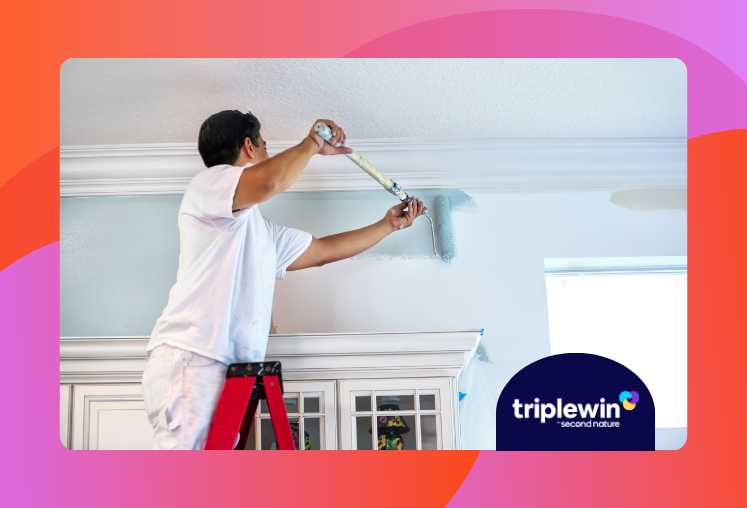Kandise Varvil has deep experience across single-family and multifamily property management as both a PM and a BDR. In 2023 she co-founded PM Pathbuilders, a property management consultancy focused on helping businesses scale efficiently. Kandise lives in Arizona and is a Triple Win Mentor.
We all know that turns can be one of the most expensive parts of property management. But what I don’t see talked about very often is what a vital role your vendors play in minimizing the time and expenses of turns.
I like to challenge the way that property management companies look at hiring vendors. Vendors bring a tremendous value to your company if you build the right relationships with them. In this article, I’ll outline why vendors are a key part of your team, how to build stronger relationships with them, and how communicating turns to your vendors proactively can save you money, time, and relationships.
Your vendors are your team
Property managers tend to see vendors as a necessary tool in their belts, but in reality vendors are as critical to our team as any employee; and should be approached with the same mentality. When they’re doing work for you, they’re functionally an extension of your team. The quality of their work reflects on your company, not theirs, so it is imperative that you set them up for success just like you would an employee. This all starts with vendor selection.
When you hire a vendor, you should be vetting them just like an employee. Ask yourself:
- Are they qualified?
- Do they have the necessary relationship skills to work with you?
- Do they understand the expectations you set for your company?
When you start to think of vendors as part of your company, you quickly realize that it’s not the vendor’s responsibility to turn a property sufficiently, it’s the management company’s. If the vendor falls short, it's not fair to shift the blame. Just as you wouldn’t call out an employee to a client, you shouldn’t throw a vendor under the bus. If the work wasn’t up to standard, that’s still on us as we made the decision to hire them.
Building strong vendor relationships
Shifting your thinking about vendors can also help you start to build important relationships with them. Vendors don’t want to feel like they’re being hired for one job and then discarded. Not only do they want to feel valued, but they also want recurring work.
In most situations, vendors value relationships with property management companies because of the consistency of work, especially in competitive markets. It means they’re getting more business on a regular basis. I know of some maintenance companies who really only took off because of the relationships they built with property managers and the steady stream of work that came from those partnerships.
As you build better relationships with vendors, you can become a preferred client, making it easier to bring vendors in for unexpected maintenance items or shorter turn times. You may also get favorable pricing or payment terms, which can add up in the long run.
Creating a vendor handbook
The other huge advantage of building vendor relationships and sticking with the same teams is that they start to learn how your company works and, importantly, what your expectations of them are.
I’m a big advocate of using a vendor handbook, just like you would have an owner handbook or an employee handbook. It helps establish expectations for the relationship upfront, and sets the tone for how you’re going to work together moving forward. It also makes the vendor feel more comfortable and get to know your company, policies, and standards.
Here’s some of what I recommend including in a vendor handbook and the questions they should answer:
- A company description: Who are you? What geography and unit types do you serve?
- Key contacts and company structure: Who will be their main point of contact? Who should they go to with questions during the work day or after hours?
- Mission, vision, and values: What are the company’s values? How should they be emulating those values when they’re working at one of your properties?
- Expectations: When the vendor walks into one of your properties, what’s expected of them? What condition are they leaving it in? How are they getting access and locking up?
- Vendor portal instructions: What do you use a portal for and where can they find it? Include a QR code with a link and an image that shows what it looks like.
- Vendor questionnaire: What information do you need from the vendor that you might not already have?
By giving your vendors the same clarity and structure you offer residents and owners, you’re setting everyone up for success. A well-designed vendor handbook not only prevents confusion but also fosters accountability and builds a stronger, more professional partnership.
Getting ahead of turns
I’m a strong believer in using task management software. At PM PathBuilders, it's one of the most impactful tools we help companies implement. They’re tremendously helpful in helping your team be more proactive about things like vacancies.
But automation alone isn’t enough. If your workflow only kicks in 30 days before a move-out, you’re already behind.
There’s a lot more you can be doing outside of an automated workflow that starts 30 days before move-out. For example, during renewal inspections or pre-move-out inspections, your team should be documenting what work is needed and creating a clear, detailed list that’s ready to go as soon as that unit is vacant.
You can even have residents do this themselves. If your state regulations allow it, consider having residents take inspection photos themselves while they’re still occupying the unit. You can even incentivize them to do so by letting them know they’ll get their security deposit back sooner to encourage participation.
You should also be tracking the age of items like carpets that have a defined life span. You should know well in advance of a vacancy whether you should be calling someone to clean the carpets or replace them. The goal is simple: gather as much information as possible before the move-out. That gives you time to line up vendors, order materials, and cut down turn time.
It pays to be proactive
Getting ahead in the game isn’t just about saving time. The more proactive you can be, the less likely you are to run into rush fees or have to find alternate vendors because your preferred vendors are already booked up. Plus, you get the added bonus of being able to give owners more lead time so they can plan for expenses, rather than feeling like it’s being sprung on them.
It also allows you to be extremely clear with your vendors about what specific work needs to be done during each turn. You shouldn’t be relying on your vendors to give you the checklist of what needs to be done. That’s like taking your car to a mechanic and asking, “what’s wrong with it?” and providing no additional information. They’ll find a laundry list of (very expensive) things they need to fix.
Instead, you already know what needs to be done and on what timeline. Sure, the vendor might suggest additional work, but then the choice is yours whether you take that to your owner as an optional service. Besides, your vendors should already know what your standards are and how to uphold them, so you should already be on the same page.
One strategy I’ve found incredibly helpful is gathering general pricing information from vendors upfront. During the vetting or onboarding process, I recommend sending out a vendor pricing sheet that includes the most common services you regularly need: like smoke detector servicing, repairing or replacing blinds, carpet cleaning, interior painting, or annual HVAC tuneups. Each vendor gives their best estimate for a price range, and now you have the information you need to select a vendor and give your owner an accurate estimate ahead of time. With enough practice, you’ll be able to calculate roughly what all your combined turnover maintenance will cost before the current resident even moves out.
Aligning your team
One last thought: your entire team must be aligned when it comes to vendor relationships.
Everyone should clearly understand:
- Who your preferred vendors are and why they were chosen
- When it’s appropriate to gather competitive bids
- The process for submitting and tracking work orders
Consistency is key. Ideally, vendor communication should run through a centralized process with a single point of contact responsible for coordination. This prevents confusion, keeps timelines on track, and ensures vendors know exactly who to communicate with.
What you want to avoid is this: one property manager having one preferred vendor while another PM has a different preferred vendor for the same work. You also don’t want multiple PMs competing for the attention of the same vendor. I once had a vendor fail to turn a property of mine because they had a closer relationship with a different PM on my team, and they had a property they needed turned.
This kind of breakdown leads to delays, inconsistent results, and ultimately, a poor experience for your owners.
Make alignment a priority. When your team speaks with one voice, your processes stay intact and your vendor partnerships get stronger.
Looking for ways to delight your residents and encourage them to stay longer? Join Second Nature’s upcoming RBP workshop to see how you can improve the resident experience.





